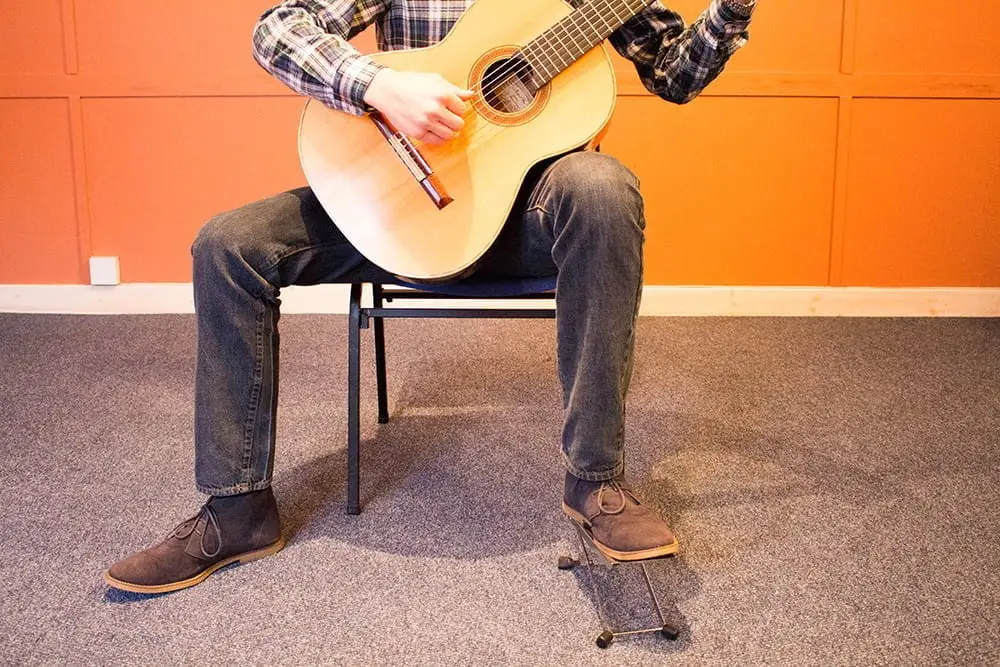For decades, many guitarists have drawn a line between “classical” and “modern” playing positions. But what if the so-called classical position offers universal benefits that every guitarist should consider? Whether you play rock, blues, folk, or jazz, adopting elements of the classical sitting position can dramatically improve your technique, comfort, and consistency. Let’s explore why this centuries-old approach deserves consideration from all guitarists who spend time playing while seated.

The Problem with “Relaxed” Sitting Positions
The typical “relaxed” position—guitar resting on the right thigh, body slouched, neck angled downward—might feel comfortable initially, but it creates several problems:
- It forces your fretting hand into awkward angles
- It creates inconsistency between your sitting and standing positions
- It can lead to back and shoulder pain during long sessions
- It limits your technical capabilities, especially for complex sections.
Most critically, when you learn in this position and then stand up to perform, the guitar shifts dramatically—changing your muscle memory, visual reference points, and overall feel.
The Classical Position: Not Just for Classical Music
The classical position involves sitting near the edge of your chair, placing the guitar on your left thigh (for right-handed players), and elevating that thigh with a footstool or support. This position:
- Places the guitar at an optimal angle for fretting
- Keeps the neck elevated for better visibility
- Maintains a straight spine to prevent back pain
- Allows for greater reach across the fretboard
What many non-classical players don’t realize is that this position wasn’t designed for a particular genre—it evolved through centuries of experimentation to find the most ergonomic, technically efficient way to play the instrument.

The Seamless Transition Between Sitting and Standing
Perhaps the most compelling reason to adopt elements of the classical position is the consistency it creates between sitting and standing postures. When the guitar is positioned properly on your left thigh with the neck elevated, it closely mimics where the guitar naturally sits when standing with a strap.
This means:
- Your hand positions remain consistent whether sitting or standing
- Your muscle memory develops more coherently
- You avoid the awkward adjustment period when transitioning from practice to performance
- Your technical facility transfers seamlessly between both positions
Using Your Strap as a Posture Tool
Many players only attach their strap when standing, but it’s actually a valuable tool when seated as well. Here’s how to use it effectively:
- Adjust your strap so the guitar sits in your preferred position when standing
- When seated, keep the strap on and adjust it so it provides light upward support
- This helps maintain the same position whether you’re sitting or standing
- The strap serves as a “safety net” that keeps the guitar from sliding during technical passages
The key is finding the perfect strap length that works in both positions—generally shorter than most rock guitarists typically use. When properly adjusted, your guitar should sit in nearly identical positions whether you’re on your feet or in a chair.
The Left Hand Advantage
With the guitar neck elevated and angled upward, your fretting hand gains several advantages:
- More natural wrist alignment, reducing strain and potential injury
- Better access to the higher frets without awkward body contortions
- Improved finger independence due to the more perpendicular approach to the fretboard
- Cleaner, more accurate fretting with less effort
This position allows your left hand to approach the neck from below rather than wrapping around from behind, creating a mechanical advantage that many “casual” positions sacrifice.
Adapting Classical Principles for Modern Players
You don’t need to adopt every aspect of classical technique to benefit from its positioning wisdom. Even partial implementation can yield significant benefits:
- Use a footstool or guitar support to elevate the instrument
- Keep the neck angled upward even if you’re playing electric
- Sit toward the edge of your chair to maintain proper posture
- Use your strap to reinforce the position even when seated
Many professional guitarists across all genres have adopted these principles while maintaining their stylistic identity. The physical laws of ergonomics apply regardless of whether you’re playing Bach or Metallica.
Long-Term Health Benefits
Beyond the immediate technical advantages, this position offers crucial long-term health benefits:
- Reduced risk of repetitive strain injuries
- Better spinal alignment preventing back pain
- Improved circulation to both arms
- Less tension in the shoulders and neck
Many guitarists who develop physical problems later in their career could have avoided them with better positioning from the beginning. The classical position represents centuries of experimentation in finding the most sustainable way to interact with the instrument.
Starting the Transition
If you’ve spent years playing in a different position, don’t worry—the transition can be gradual:
- Start with short practice sessions in the new position
- Use a mirror to check your posture
- Take frequent breaks as your body adapts
- Consider working with a teacher who understands proper positioning
The initial discomfort will fade as your body adapts, revealing the greater comfort and facility this position ultimately provides.
Conclusion: A Universal Approach
While it’s called the “classical” position, there’s nothing genre-specific about good ergonomics. This approach to holding the guitar represents the accumulated wisdom of generations of players seeking the most efficient, comfortable, and technically advantageous way to play this instrument.
By adopting these principles, you’re not becoming a classical guitarist—you’re becoming a more efficient, consistent, and healthy guitarist who can move seamlessly between practice and performance. Your future self, free of unnecessary pain and technical limitations, will thank you for making this change.
About The Author
Brian Fish is a professional guitarist who has been dedicated to helping other guitar players in Northeast Ohio pursue their musical dreams since 1994. He’s passionate about guiding others on their musical journey! He is the Guitar Playing Transformation Specialist, instructor, mentor, trainer, and coach at Guitar Lessons Geauga.
Brian has also assisted people from around the globe in developing a solid sense of timing and enhancing their creativity through the fantastic rhythm course, “Ultimate Rhythm Mastery,” available at MusicTheoryForGuitar.com.
If you live in Geauga County / North East Ohio, Guitar Lessons Geauga can help you become the player you’ve always wanted to be.

